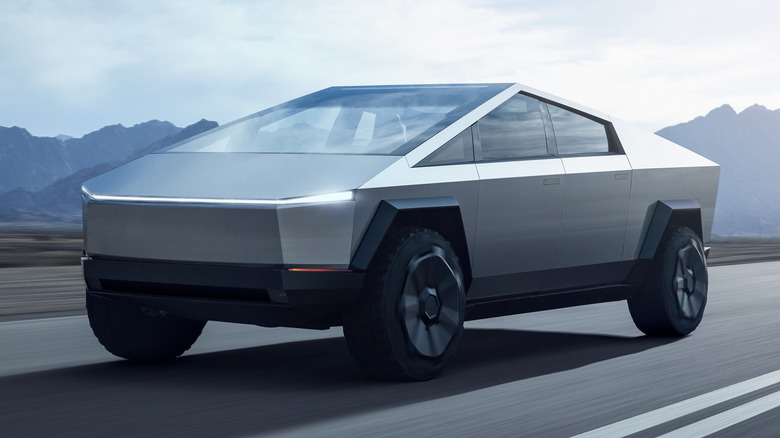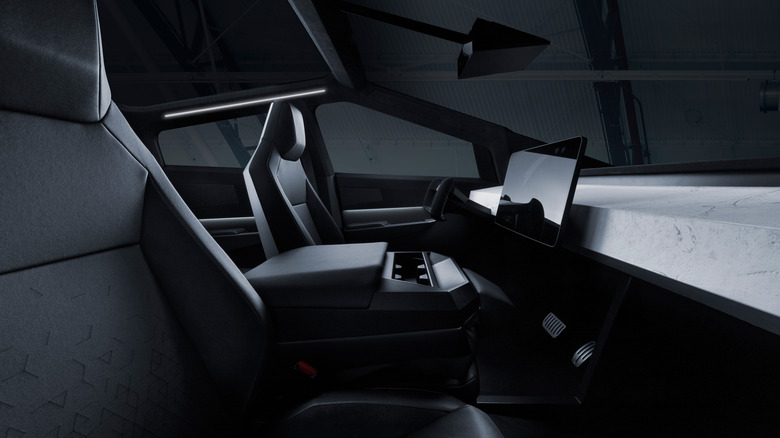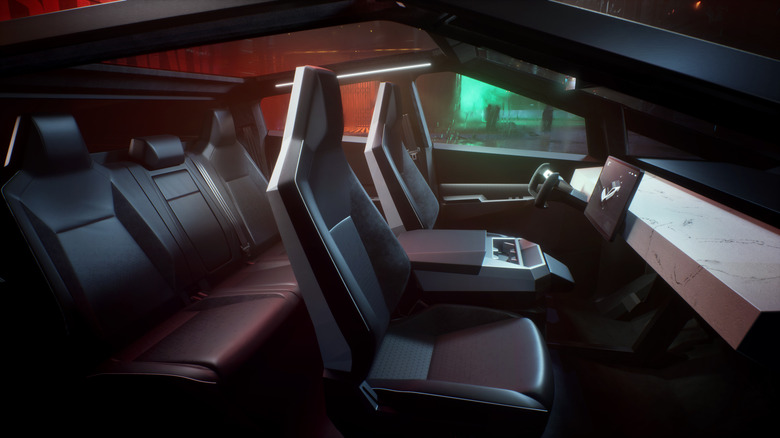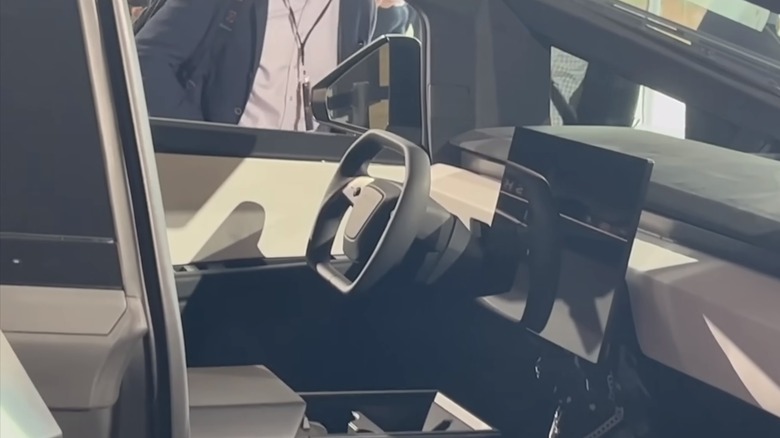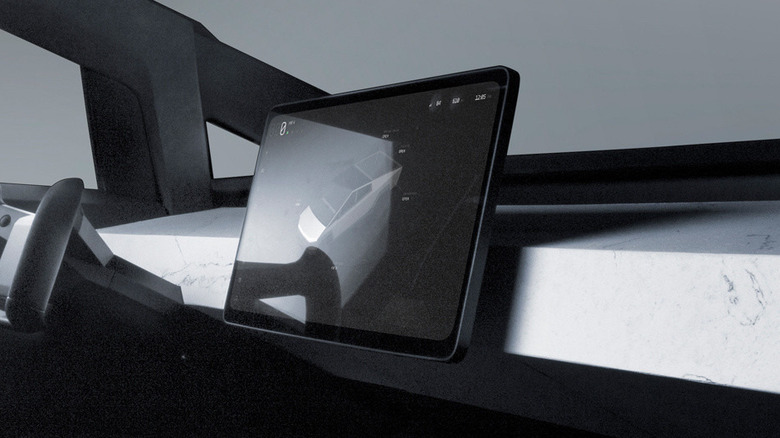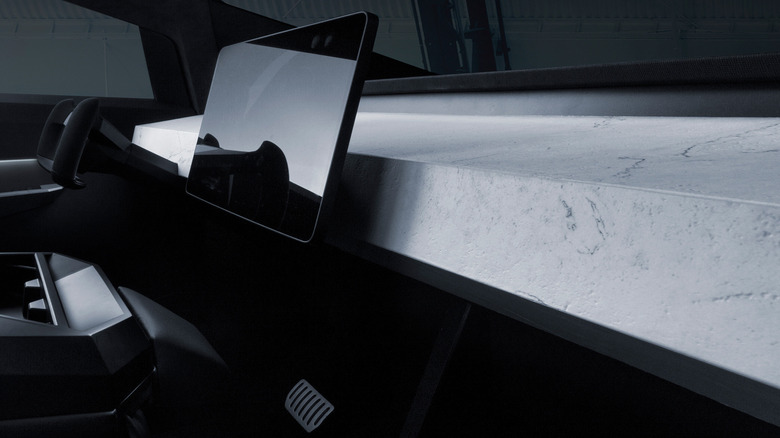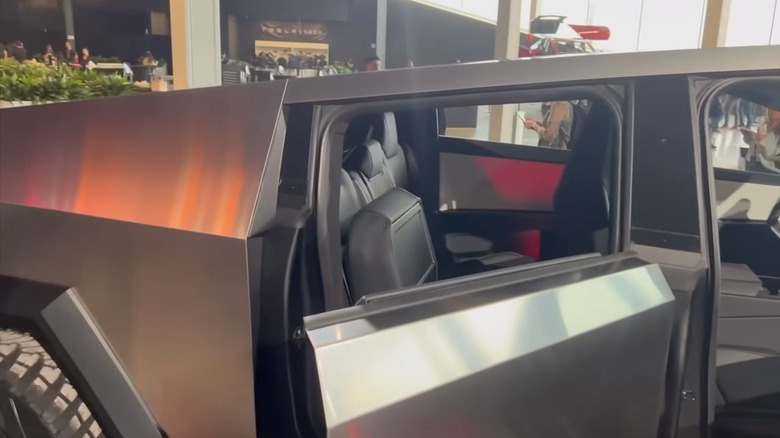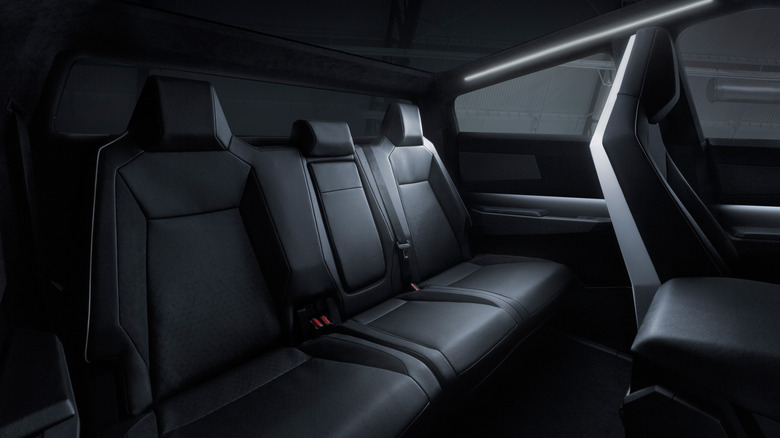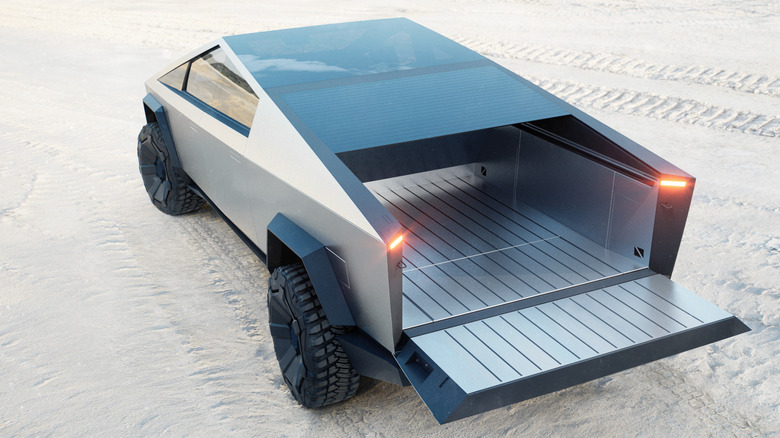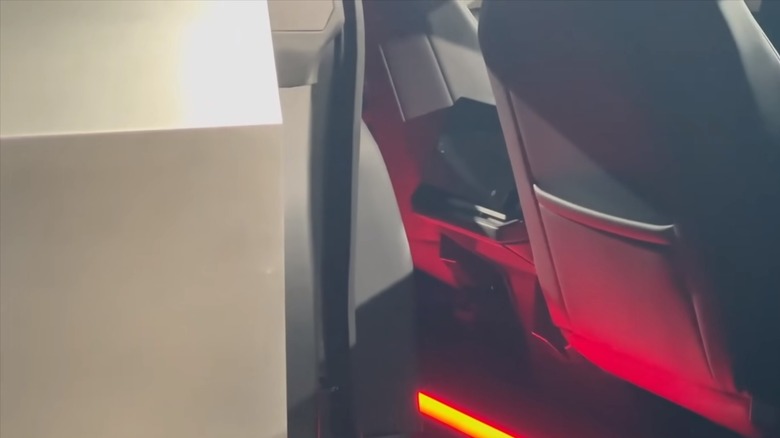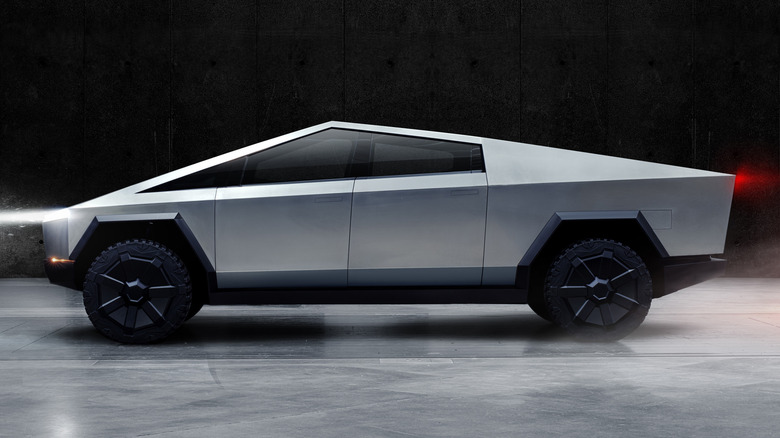The Coolest Features Of The Tesla Cybertruck Interior
The Tesla Cybertruck is one of the brand's most eagerly awaited vehicles to date, and after years of delays, the company has promised that it'll finally be in production by the end of 2023. At the most recent Investor Day, Tesla let attendees check out a pre-production version of the truck, including taking a look at its sleek interior. There appear to be some key changes compared to the original design that first broke cover in 2019, but overall, the automaker has done a remarkably good job of preserving the futuristic feel of the initial concept.
It's worth keeping in mind that the version shown off at Investor Day was still a pre-production model, so there's a chance that further revisions might be made to the interior before it gets released to customers. However, with only months to go until the claimed start of production, it would appear that this latest iteration of the Cybertruck should be pretty similar to the version that Tesla fans can expect to start appearing on the roads soon.
Minimalist design
The angular, industrial design of the Cybertruck's exterior is unlike any production vehicle currently in Tesla's roster, and with such a radical new approach to the outside, many were left wondering if an equally radical design would debut in the interior. In fact, it doesn't seem like Tesla is trying to change things up too much here. The Cybertruck's minimalist interior shares much of its design language with the production models 3, S, X, and Y, with a simplistic layout and the vast majority of its controls accessible through the central touchscreen.
The ethos of omitting traditional buttons and dials and replacing them with touchscreen functions is one that was originally popularized by Tesla, but has become an increasingly common sight on EVs from rival automakers too. Clearly, Tesla saw no reason to change things for the Cybertruck, and the result is an interior that looks distinctly Tesla even if its competitors will no doubt be making notes.
Panoramic glass roof
The glass roof is a standard feature on Tesla's cars already, and it's one of its coolest innovations as a carmaker. Especially when you're sitting in the rear seats, there's a more airy feel than with a traditional metal roof, and of course, visibility is excellent for both driver and passengers. The Cybertruck is set to keep the glass roof seen in the original concept, although it's not been confirmed yet whether a metal roof option will also be available.
It might be a brilliant piece of engineering, but it's likely that the glass roof will be an expensive item to repair if it cracks. A Tesla Model X owner was quoted $2,290 to replace a cracked windshield, which Elon Musk claimed was the largest single piece of glass ever fitted to a production car at the time. Replacing the glass roof on a Model Y costs somewhere around $1,600 according to various owner reports, and the Model 3 roof glass is reported to be the cheapest, with a replacement costing just over $1,000 including labor. No matter whether the Cybertruck's glass replacement costs fall closer to the Model 3 or Model X, it's still going to be an unwelcome expense for anyone lucky enough to get a chip in the roof of their new Cybertruck, but until then, at least it looks cool.
New steering yoke
The steering yoke that can be seen in pictures of the pre-production Cybertruck unveiled at Investor Day is unlike the one currently adorning the brand's Model S and X production cars, and in this case, that's probably a good thing. It was one of the most controversial features introduced in the 2021 model year overhaul, and despite plenty of backlash from buyers, Elon Musk initially insisted that Tesla would not be providing an alternative option. One of the main concerns some buyers had with the yoke was that it cut away the top part of the traditional steering wheel shape, leaving slow-speed maneuvers potentially more tricky to accomplish.
Musk eventually changed his mind and unveiled a retrofit option for the Model S and X, which sold out shortly after its launch. It seems the Tesla CEO and his design team have taken drivers' concerns to heart, as the Cybertruck's redesigned "yoke" now looks a lot more like a regular steering wheel again, with a more traditional design that should be a lot easier to get to grips with.
Large central touchscreen
One of Tesla's signature interior design touches has always been its large touchscreen, which sits in place of a traditional center console. The Cybertruck follows tradition and packs a 17-inch screen, which Tesla says will sport an all-new interface that's been specifically designed for the truck. Not much of what this new interface is yet available for viewing since the screen in the pre-production vehicle shown at Investor Day wasn't on.
Nonetheless, it's safe to make some assumptions based on what else has already been revealed in the interior. The Cybertruck's dash and steering wheel are almost entirely free of buttons and switches, so expect almost every function and feature to be controlled through the screen — no change from previous models there, then. However, there does appear to be a separate instrument cluster, unlike the Model 3, which infamously omits one in favor of displaying everything on the central screen. The lack of a cluster in the Model 3 is arguably one of the car's biggest faults, so it's good to see that the Cybertruck has opted for a more user-friendly conventional layout.
Recycled paper dash
One of the most interesting revelations from the initial Cybertruck launch in 2019 was that the dash was made not from plastic, leather, or any of the usual materials, but from recycled paper. Initial reports claimed that the material felt like high-quality cardboard to touch, but from a distance, looked almost metallic in nature. Images of the Investor Day prototype show that Tesla appears to have stuck with this material, but at the time of writing, few other details about it have been officially confirmed.
It will also be worth watching how well the paper dash holds up to real-world use over longer periods of time, as Tesla's previous material innovations have not been without their problems. In 2019, the automaker announced it would be removing animal products from its cars entirely, using "vegan leather" instead of regular leather for the cabin furnishings. This new leather looks great, especially in its futuristic all-white guise, but there have been concerns raised over its longevity. When Tesla's vegan leather was first unveiled, a number of owners reported their cars' seats cracking or bubbling, although the rate of these reports seems to have died down recently. Teething problems are far from unusual when developing new materials like this, so let's hope the Cybertruck's new paper dash doesn't suffer from similar wear and tear issues at launch.
Folding rear seats
As far back as 2021, it was reported that the Cybertruck might feature rear seats that could fold down to enable the truck bed to be accessed from inside the cabin. This would have a variety of benefits – for starters, it could enable longer cargo to be transported and would provide an easy way of accessing cargo without opening the tailgate. It could also be used to convert the Cybertruck into a futuristic camper, with the extra length meaning a double mattress could be placed in the back and used in tandem with the optional rear-mounted tent.
While the specifics have yet to be confirmed, images from the Investor Day in March show the seats folding upwards, but not downwards. It appeared that Tesla filed a patent for the fold-down rear seats in 2021, but whether this feature will make it to the final product remains unclear for now. Either way, it seems like the seats will be foldable to some degree to optimize the cabin space for either cargo or passengers.
Storage under the seats
While some might see it as a good thing, a general lack of interior storage space was one of the more common complaints about Tesla's earlier cars. The 2021 redesign of the Model S added modest door pockets, but that was about as far as Tesla went to address those concerns. On a more utilitarian vehicle like the Cybertruck, having no storage space might be more of a deal breaker, so Tesla has added extra storage under the second row of seats.
The pre-production truck at Investor Day also featured door pockets and a small storage cubby in the center console, although that's still less storage overall than most of the best-selling gas-powered pickups offer. Fans will have to wait until the final production version is unveiled before finding out if Musk and his team have engineered any other clever ways to store work essentials, tech, tools, or any other bits and pieces that the average pickup buyer might want to keep handy.
Cameras instead of side mirrors
Tesla isn't the first automaker to put forward the idea of using a camera system instead of relying on traditional mirrors, but Elon Musk has made it more clear than most where his opinion lies on the idea. In 2021, he claimed that the Cybertruck's mirrors will be easy for owners to remove, although for now, they have to fit them by law. That law, however, is under review, and it's possible that regulators will approve camera-only systems in the near future. Different states already vary in the number of mirrors they require a vehicle to have, with states like Oklahoma and Utah only requiring two mirrors rather than three.
Early prototypes of the truck featured either no mirrors at all or ones with a rectangular design, but the most recent prototypes have been spotted with triangular mirrors that better fit the angular, futuristic look of the truck. If Musk keeps his promise and the mirrors are indeed easily removable, it's hard not to imagine some owners removing the mirrors from day one and just relying on the cameras in order to make their truck look as unique as possible, even if it puts them at risk of getting a citation.
Screen for rear passengers
Tesla's rear touchscreen provides passengers with access to media and climate controls, and it's been available for a while across the automaker's range. It seems the Cybertruck will also be getting one, as the images from the Investor Day event show the pre-production vehicle has one fitted. Rear screens in current production cars have controls for things like cabin temperature, fans, and seat adjustment, alongside access to Tesla's music and video streaming services. It can be disabled from the front touchscreen if the driver decides not to let rear passengers access the controls, however.
Eventually, there's a chance that passengers might be able to play Steam games in the back of the Cybertruck, as Musk has claimed to be working on integrating the gaming platform to allow almost any major release to be played in-car. That feature is likely still a way away yet, but it's not as far-fetched as it might seem, as Tesla's newest chips already have the power to play even AAA titles. For now, though, Steam integration is just another one of Musk's many ideas that have yet to make it to customer cars.
Armored glass
Perhaps the most infamous moment of the Cybertruck reveal was when chief designer Franz von Holzhausen threw a heavy steel ball at the supposedly armored glass and broke the front window, causing Elon Musk to suggest throwing it at the rear window, only for it to break again. That embarrassing episode means that Tesla will be very keen to make sure the glass is fully strengthened for when the first deliveries reach customers. This will, of course, be shortly followed by content creators throwing things at the windows to test them and try to create their own viral window-shattering moment.
However, Tesla's patent for the glass doesn't claim it to be "bulletproof" or "unbreakable" like it was initially suggested, but rather an impact resistant. Specifically, it should be able to withstand a 1.1-pound mass being dropped on it from a height of up to 15.8 inches, 90% of the time. Still an impressive feat, but not a match for bullets, high-speed projectiles, or even, it seems, a heavy steel ball.
